Analyzing HR Services and Employee Retention in Organizations
VerifiedAdded on 2022/08/13
|29
|7958
|50
Report
AI Summary
This report investigates the critical role of HR services in employee retention within business organizations. It begins by defining employee retention and its significance, highlighting the importance of HR in fostering a positive work environment and implementing strategies to reduce employee turnover. The report outlines the aims, objectives, and research questions, followed by a comprehensive literature review examining existing research on employee retention factors, gender-neutral workplaces, talent management, and the role of HR departments. The research methodology, including the research philosophy, design, data collection, and analysis techniques, is clearly described. The findings are then presented and analyzed, focusing on how HR managers use one-on-one interactions, bonus and incentive information, and address issues like leaves and punctuality to retain employees. The study concludes by emphasizing the impact of a positive work culture and good remuneration on employee retention, offering valuable recommendations for organizations seeking to improve their retention rates. The report contributes to a deeper understanding of the strategies and challenges involved in employee retention and the pivotal role of HR in ensuring employee loyalty and organizational success.
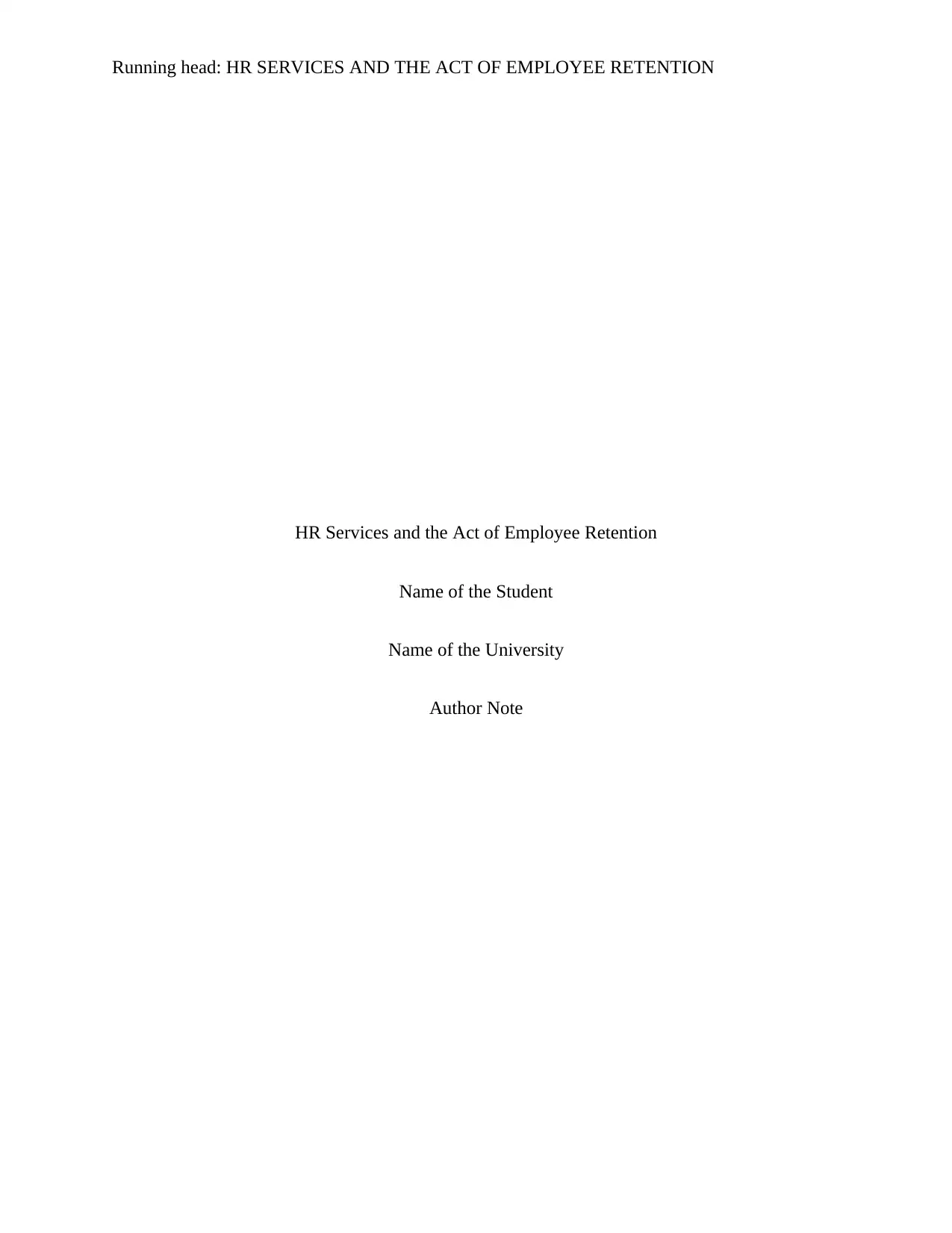
Running head: HR SERVICES AND THE ACT OF EMPLOYEE RETENTION
HR Services and the Act of Employee Retention
Name of the Student
Name of the University
Author Note
HR Services and the Act of Employee Retention
Name of the Student
Name of the University
Author Note
Paraphrase This Document
Need a fresh take? Get an instant paraphrase of this document with our AI Paraphraser
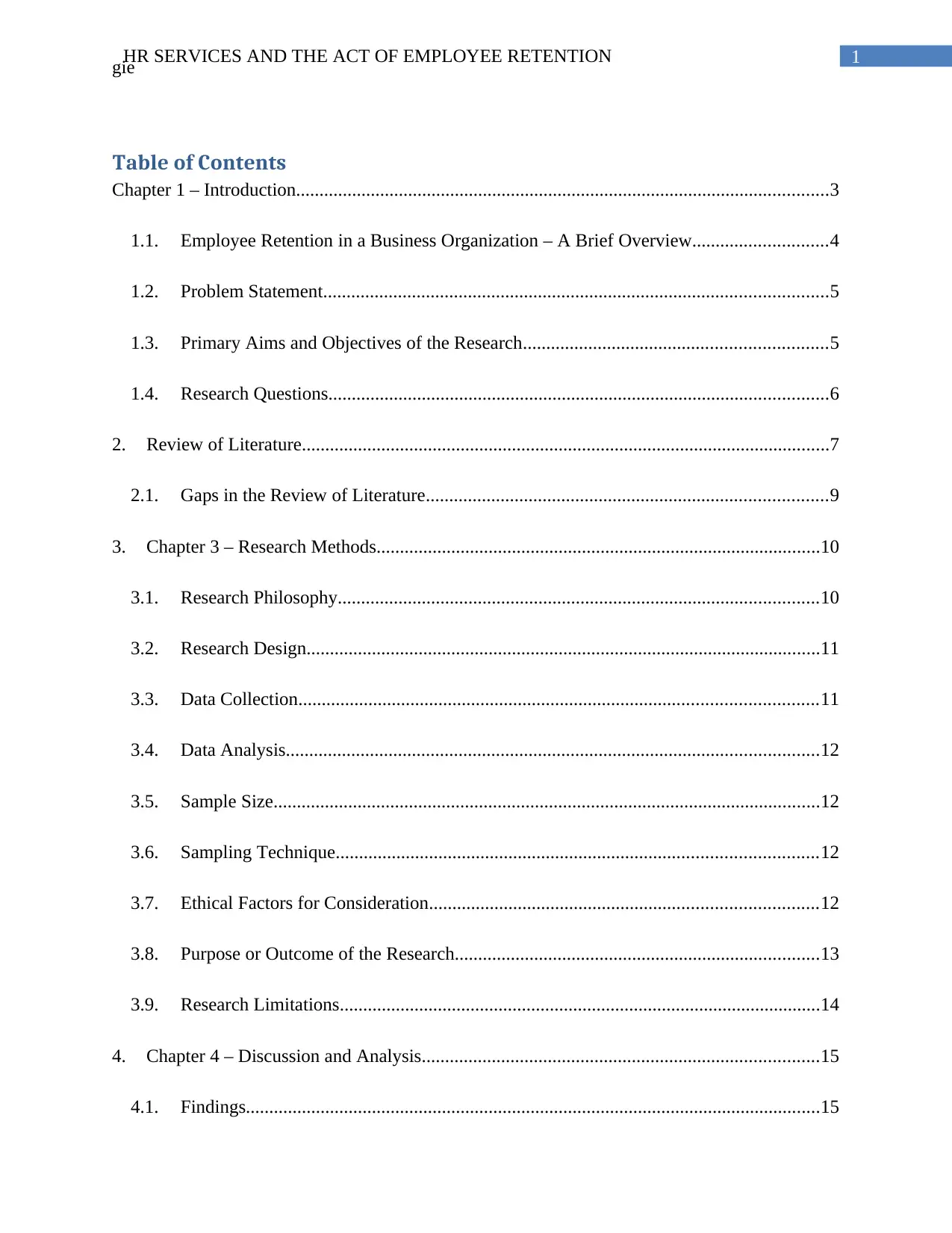
1HR SERVICES AND THE ACT OF EMPLOYEE RETENTION
gie
Table of Contents
Chapter 1 – Introduction..................................................................................................................3
1.1. Employee Retention in a Business Organization – A Brief Overview.............................4
1.2. Problem Statement............................................................................................................5
1.3. Primary Aims and Objectives of the Research.................................................................5
1.4. Research Questions...........................................................................................................6
2. Review of Literature.................................................................................................................7
2.1. Gaps in the Review of Literature......................................................................................9
3. Chapter 3 – Research Methods...............................................................................................10
3.1. Research Philosophy.......................................................................................................10
3.2. Research Design..............................................................................................................11
3.3. Data Collection...............................................................................................................11
3.4. Data Analysis..................................................................................................................12
3.5. Sample Size.....................................................................................................................12
3.6. Sampling Technique.......................................................................................................12
3.7. Ethical Factors for Consideration...................................................................................12
3.8. Purpose or Outcome of the Research..............................................................................13
3.9. Research Limitations.......................................................................................................14
4. Chapter 4 – Discussion and Analysis.....................................................................................15
4.1. Findings...........................................................................................................................15
gie
Table of Contents
Chapter 1 – Introduction..................................................................................................................3
1.1. Employee Retention in a Business Organization – A Brief Overview.............................4
1.2. Problem Statement............................................................................................................5
1.3. Primary Aims and Objectives of the Research.................................................................5
1.4. Research Questions...........................................................................................................6
2. Review of Literature.................................................................................................................7
2.1. Gaps in the Review of Literature......................................................................................9
3. Chapter 3 – Research Methods...............................................................................................10
3.1. Research Philosophy.......................................................................................................10
3.2. Research Design..............................................................................................................11
3.3. Data Collection...............................................................................................................11
3.4. Data Analysis..................................................................................................................12
3.5. Sample Size.....................................................................................................................12
3.6. Sampling Technique.......................................................................................................12
3.7. Ethical Factors for Consideration...................................................................................12
3.8. Purpose or Outcome of the Research..............................................................................13
3.9. Research Limitations.......................................................................................................14
4. Chapter 4 – Discussion and Analysis.....................................................................................15
4.1. Findings...........................................................................................................................15
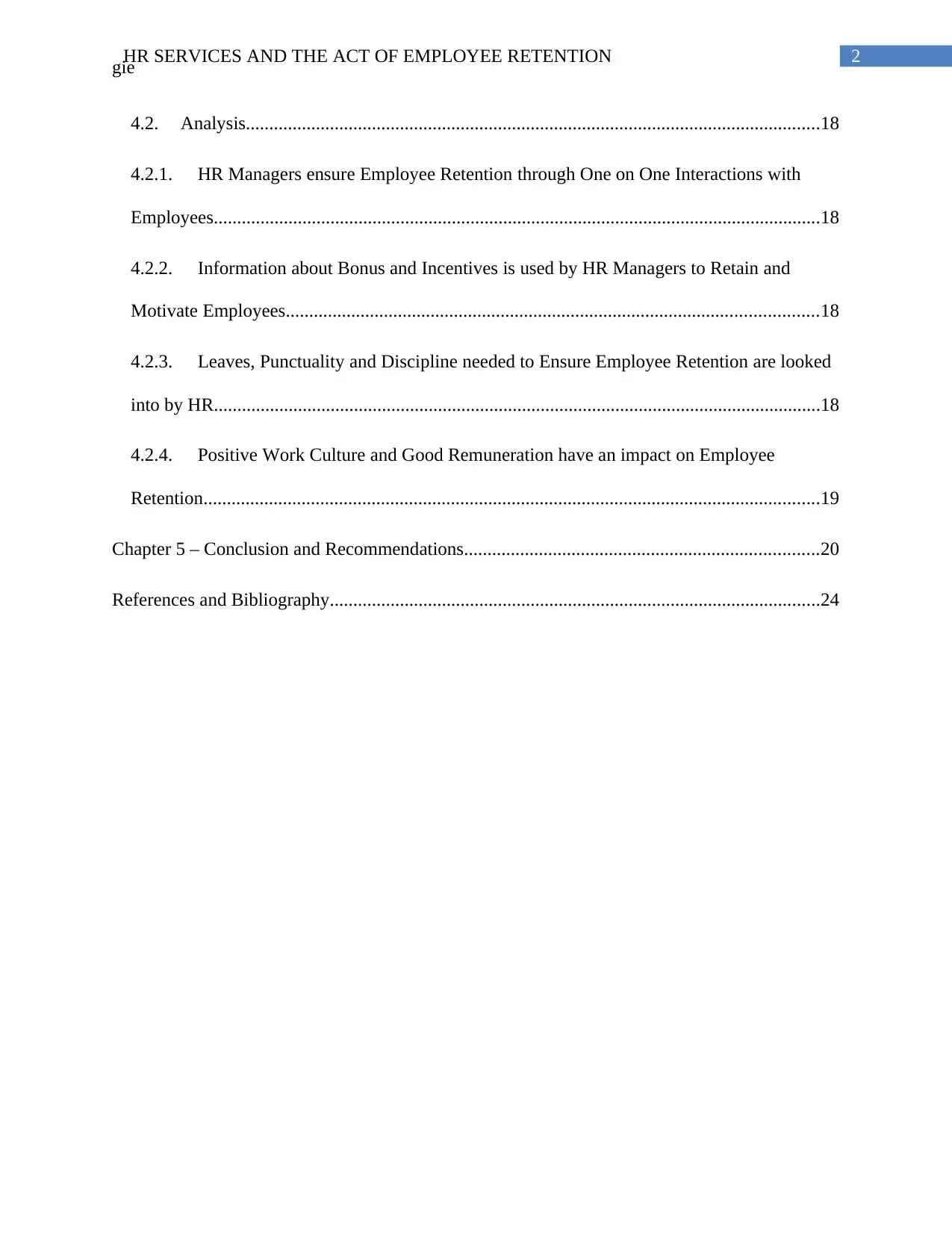
2HR SERVICES AND THE ACT OF EMPLOYEE RETENTION
gie
4.2. Analysis...........................................................................................................................18
4.2.1. HR Managers ensure Employee Retention through One on One Interactions with
Employees..................................................................................................................................18
4.2.2. Information about Bonus and Incentives is used by HR Managers to Retain and
Motivate Employees..................................................................................................................18
4.2.3. Leaves, Punctuality and Discipline needed to Ensure Employee Retention are looked
into by HR..................................................................................................................................18
4.2.4. Positive Work Culture and Good Remuneration have an impact on Employee
Retention....................................................................................................................................19
Chapter 5 – Conclusion and Recommendations............................................................................20
References and Bibliography.........................................................................................................24
gie
4.2. Analysis...........................................................................................................................18
4.2.1. HR Managers ensure Employee Retention through One on One Interactions with
Employees..................................................................................................................................18
4.2.2. Information about Bonus and Incentives is used by HR Managers to Retain and
Motivate Employees..................................................................................................................18
4.2.3. Leaves, Punctuality and Discipline needed to Ensure Employee Retention are looked
into by HR..................................................................................................................................18
4.2.4. Positive Work Culture and Good Remuneration have an impact on Employee
Retention....................................................................................................................................19
Chapter 5 – Conclusion and Recommendations............................................................................20
References and Bibliography.........................................................................................................24
⊘ This is a preview!⊘
Do you want full access?
Subscribe today to unlock all pages.

Trusted by 1+ million students worldwide
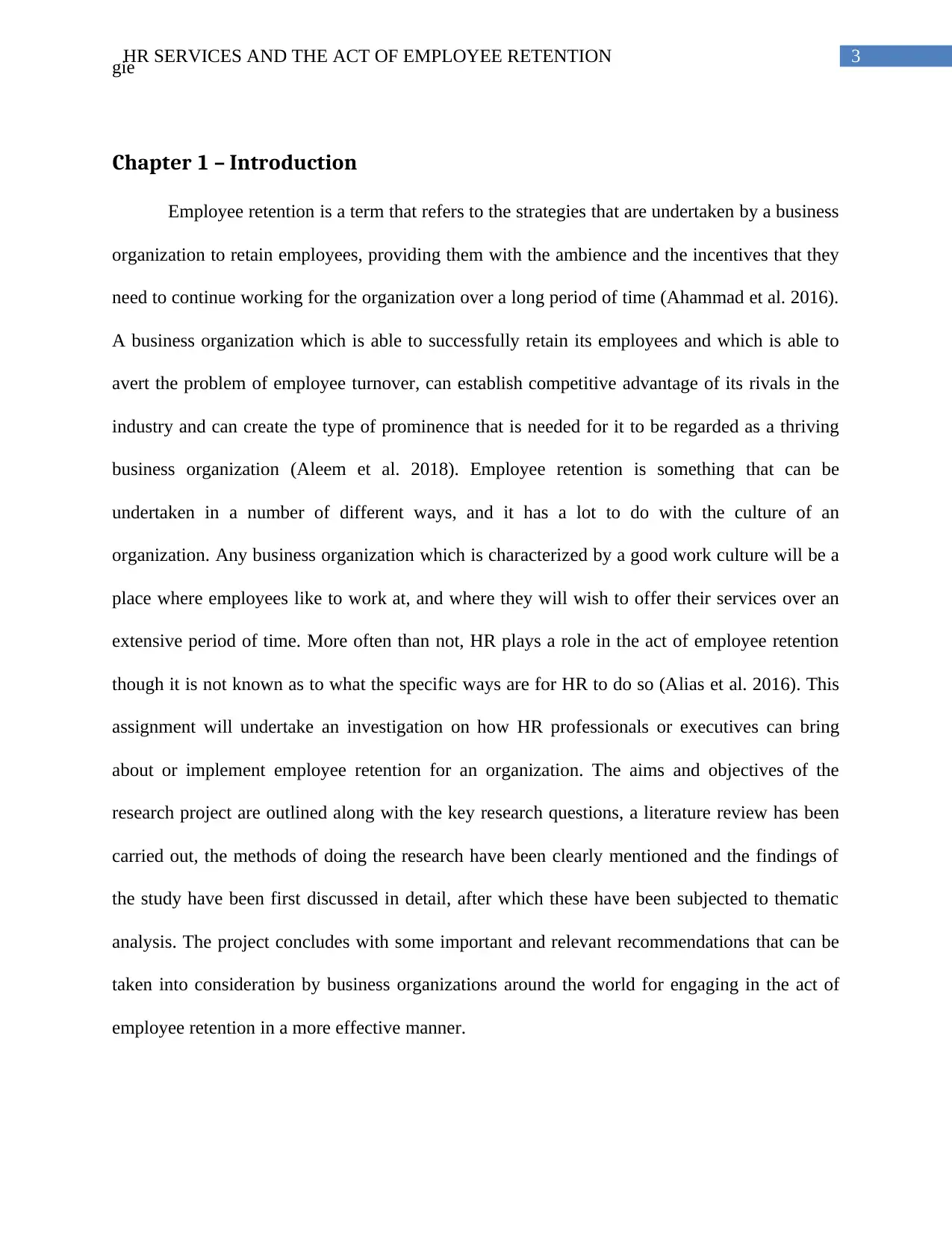
3HR SERVICES AND THE ACT OF EMPLOYEE RETENTION
gie
Chapter 1 – Introduction
Employee retention is a term that refers to the strategies that are undertaken by a business
organization to retain employees, providing them with the ambience and the incentives that they
need to continue working for the organization over a long period of time (Ahammad et al. 2016).
A business organization which is able to successfully retain its employees and which is able to
avert the problem of employee turnover, can establish competitive advantage of its rivals in the
industry and can create the type of prominence that is needed for it to be regarded as a thriving
business organization (Aleem et al. 2018). Employee retention is something that can be
undertaken in a number of different ways, and it has a lot to do with the culture of an
organization. Any business organization which is characterized by a good work culture will be a
place where employees like to work at, and where they will wish to offer their services over an
extensive period of time. More often than not, HR plays a role in the act of employee retention
though it is not known as to what the specific ways are for HR to do so (Alias et al. 2016). This
assignment will undertake an investigation on how HR professionals or executives can bring
about or implement employee retention for an organization. The aims and objectives of the
research project are outlined along with the key research questions, a literature review has been
carried out, the methods of doing the research have been clearly mentioned and the findings of
the study have been first discussed in detail, after which these have been subjected to thematic
analysis. The project concludes with some important and relevant recommendations that can be
taken into consideration by business organizations around the world for engaging in the act of
employee retention in a more effective manner.
gie
Chapter 1 – Introduction
Employee retention is a term that refers to the strategies that are undertaken by a business
organization to retain employees, providing them with the ambience and the incentives that they
need to continue working for the organization over a long period of time (Ahammad et al. 2016).
A business organization which is able to successfully retain its employees and which is able to
avert the problem of employee turnover, can establish competitive advantage of its rivals in the
industry and can create the type of prominence that is needed for it to be regarded as a thriving
business organization (Aleem et al. 2018). Employee retention is something that can be
undertaken in a number of different ways, and it has a lot to do with the culture of an
organization. Any business organization which is characterized by a good work culture will be a
place where employees like to work at, and where they will wish to offer their services over an
extensive period of time. More often than not, HR plays a role in the act of employee retention
though it is not known as to what the specific ways are for HR to do so (Alias et al. 2016). This
assignment will undertake an investigation on how HR professionals or executives can bring
about or implement employee retention for an organization. The aims and objectives of the
research project are outlined along with the key research questions, a literature review has been
carried out, the methods of doing the research have been clearly mentioned and the findings of
the study have been first discussed in detail, after which these have been subjected to thematic
analysis. The project concludes with some important and relevant recommendations that can be
taken into consideration by business organizations around the world for engaging in the act of
employee retention in a more effective manner.
Paraphrase This Document
Need a fresh take? Get an instant paraphrase of this document with our AI Paraphraser
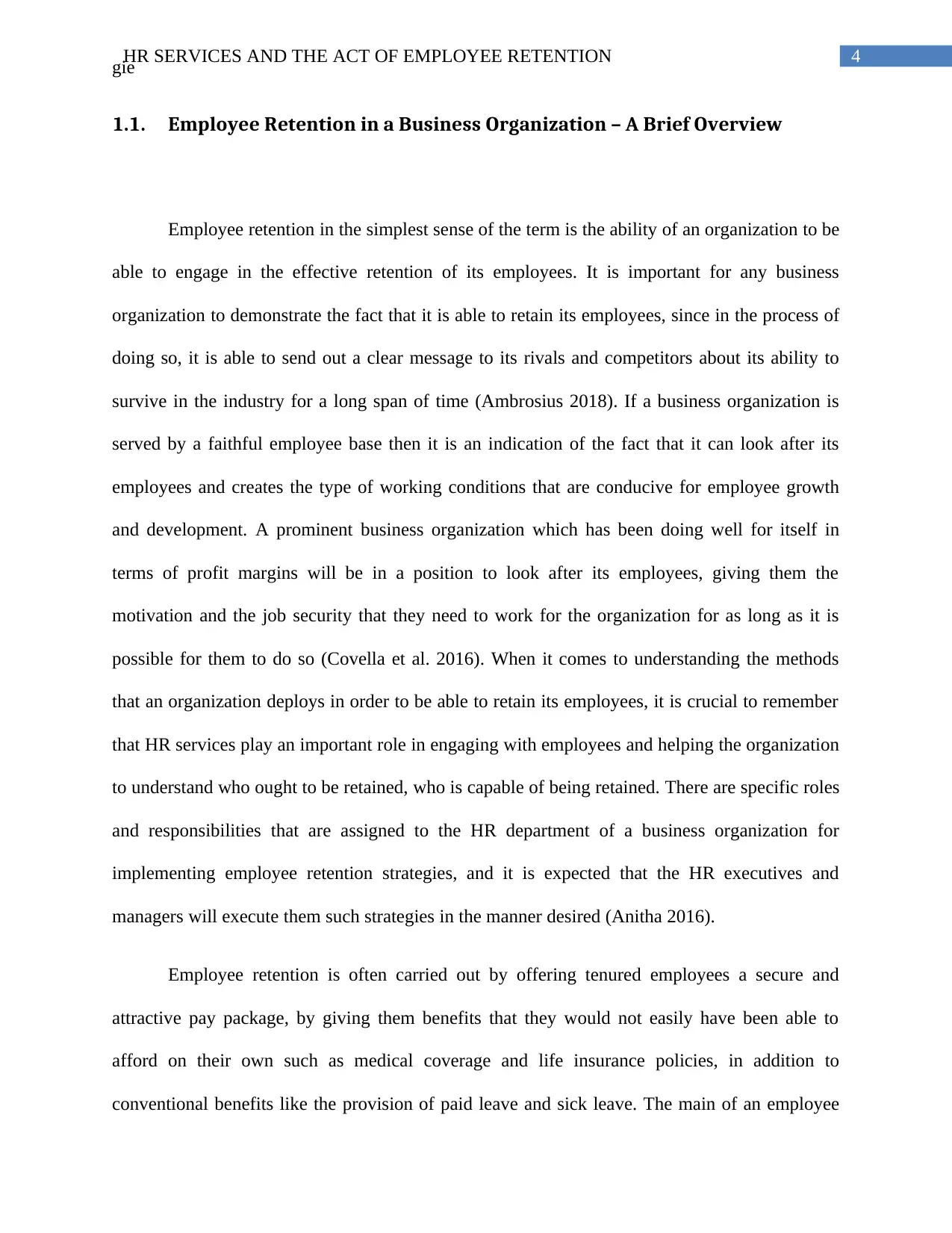
4HR SERVICES AND THE ACT OF EMPLOYEE RETENTION
gie
1.1. Employee Retention in a Business Organization – A Brief Overview
Employee retention in the simplest sense of the term is the ability of an organization to be
able to engage in the effective retention of its employees. It is important for any business
organization to demonstrate the fact that it is able to retain its employees, since in the process of
doing so, it is able to send out a clear message to its rivals and competitors about its ability to
survive in the industry for a long span of time (Ambrosius 2018). If a business organization is
served by a faithful employee base then it is an indication of the fact that it can look after its
employees and creates the type of working conditions that are conducive for employee growth
and development. A prominent business organization which has been doing well for itself in
terms of profit margins will be in a position to look after its employees, giving them the
motivation and the job security that they need to work for the organization for as long as it is
possible for them to do so (Covella et al. 2016). When it comes to understanding the methods
that an organization deploys in order to be able to retain its employees, it is crucial to remember
that HR services play an important role in engaging with employees and helping the organization
to understand who ought to be retained, who is capable of being retained. There are specific roles
and responsibilities that are assigned to the HR department of a business organization for
implementing employee retention strategies, and it is expected that the HR executives and
managers will execute them such strategies in the manner desired (Anitha 2016).
Employee retention is often carried out by offering tenured employees a secure and
attractive pay package, by giving them benefits that they would not easily have been able to
afford on their own such as medical coverage and life insurance policies, in addition to
conventional benefits like the provision of paid leave and sick leave. The main of an employee
gie
1.1. Employee Retention in a Business Organization – A Brief Overview
Employee retention in the simplest sense of the term is the ability of an organization to be
able to engage in the effective retention of its employees. It is important for any business
organization to demonstrate the fact that it is able to retain its employees, since in the process of
doing so, it is able to send out a clear message to its rivals and competitors about its ability to
survive in the industry for a long span of time (Ambrosius 2018). If a business organization is
served by a faithful employee base then it is an indication of the fact that it can look after its
employees and creates the type of working conditions that are conducive for employee growth
and development. A prominent business organization which has been doing well for itself in
terms of profit margins will be in a position to look after its employees, giving them the
motivation and the job security that they need to work for the organization for as long as it is
possible for them to do so (Covella et al. 2016). When it comes to understanding the methods
that an organization deploys in order to be able to retain its employees, it is crucial to remember
that HR services play an important role in engaging with employees and helping the organization
to understand who ought to be retained, who is capable of being retained. There are specific roles
and responsibilities that are assigned to the HR department of a business organization for
implementing employee retention strategies, and it is expected that the HR executives and
managers will execute them such strategies in the manner desired (Anitha 2016).
Employee retention is often carried out by offering tenured employees a secure and
attractive pay package, by giving them benefits that they would not easily have been able to
afford on their own such as medical coverage and life insurance policies, in addition to
conventional benefits like the provision of paid leave and sick leave. The main of an employee
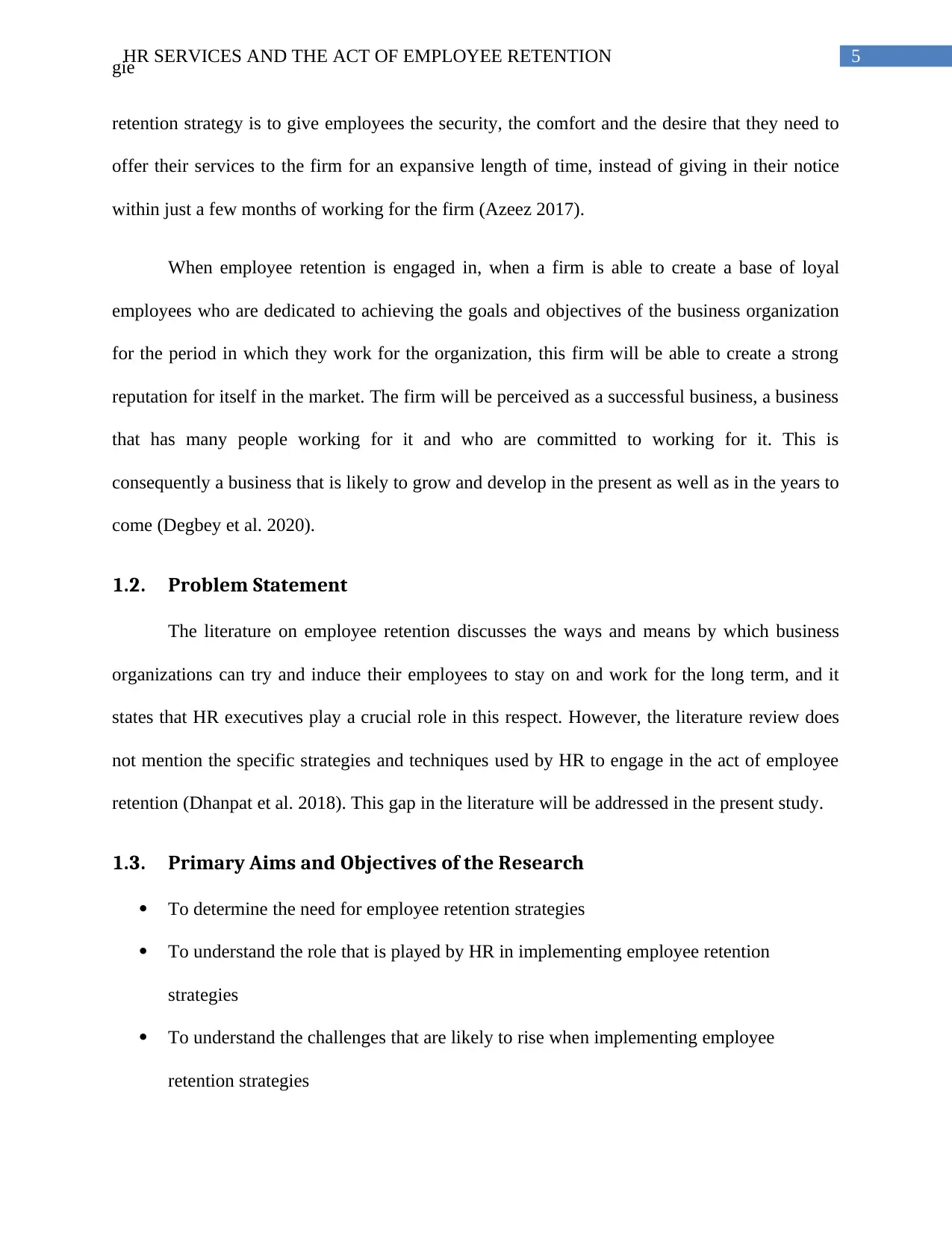
5HR SERVICES AND THE ACT OF EMPLOYEE RETENTION
gie
retention strategy is to give employees the security, the comfort and the desire that they need to
offer their services to the firm for an expansive length of time, instead of giving in their notice
within just a few months of working for the firm (Azeez 2017).
When employee retention is engaged in, when a firm is able to create a base of loyal
employees who are dedicated to achieving the goals and objectives of the business organization
for the period in which they work for the organization, this firm will be able to create a strong
reputation for itself in the market. The firm will be perceived as a successful business, a business
that has many people working for it and who are committed to working for it. This is
consequently a business that is likely to grow and develop in the present as well as in the years to
come (Degbey et al. 2020).
1.2. Problem Statement
The literature on employee retention discusses the ways and means by which business
organizations can try and induce their employees to stay on and work for the long term, and it
states that HR executives play a crucial role in this respect. However, the literature review does
not mention the specific strategies and techniques used by HR to engage in the act of employee
retention (Dhanpat et al. 2018). This gap in the literature will be addressed in the present study.
1.3. Primary Aims and Objectives of the Research
To determine the need for employee retention strategies
To understand the role that is played by HR in implementing employee retention
strategies
To understand the challenges that are likely to rise when implementing employee
retention strategies
gie
retention strategy is to give employees the security, the comfort and the desire that they need to
offer their services to the firm for an expansive length of time, instead of giving in their notice
within just a few months of working for the firm (Azeez 2017).
When employee retention is engaged in, when a firm is able to create a base of loyal
employees who are dedicated to achieving the goals and objectives of the business organization
for the period in which they work for the organization, this firm will be able to create a strong
reputation for itself in the market. The firm will be perceived as a successful business, a business
that has many people working for it and who are committed to working for it. This is
consequently a business that is likely to grow and develop in the present as well as in the years to
come (Degbey et al. 2020).
1.2. Problem Statement
The literature on employee retention discusses the ways and means by which business
organizations can try and induce their employees to stay on and work for the long term, and it
states that HR executives play a crucial role in this respect. However, the literature review does
not mention the specific strategies and techniques used by HR to engage in the act of employee
retention (Dhanpat et al. 2018). This gap in the literature will be addressed in the present study.
1.3. Primary Aims and Objectives of the Research
To determine the need for employee retention strategies
To understand the role that is played by HR in implementing employee retention
strategies
To understand the challenges that are likely to rise when implementing employee
retention strategies
⊘ This is a preview!⊘
Do you want full access?
Subscribe today to unlock all pages.

Trusted by 1+ million students worldwide
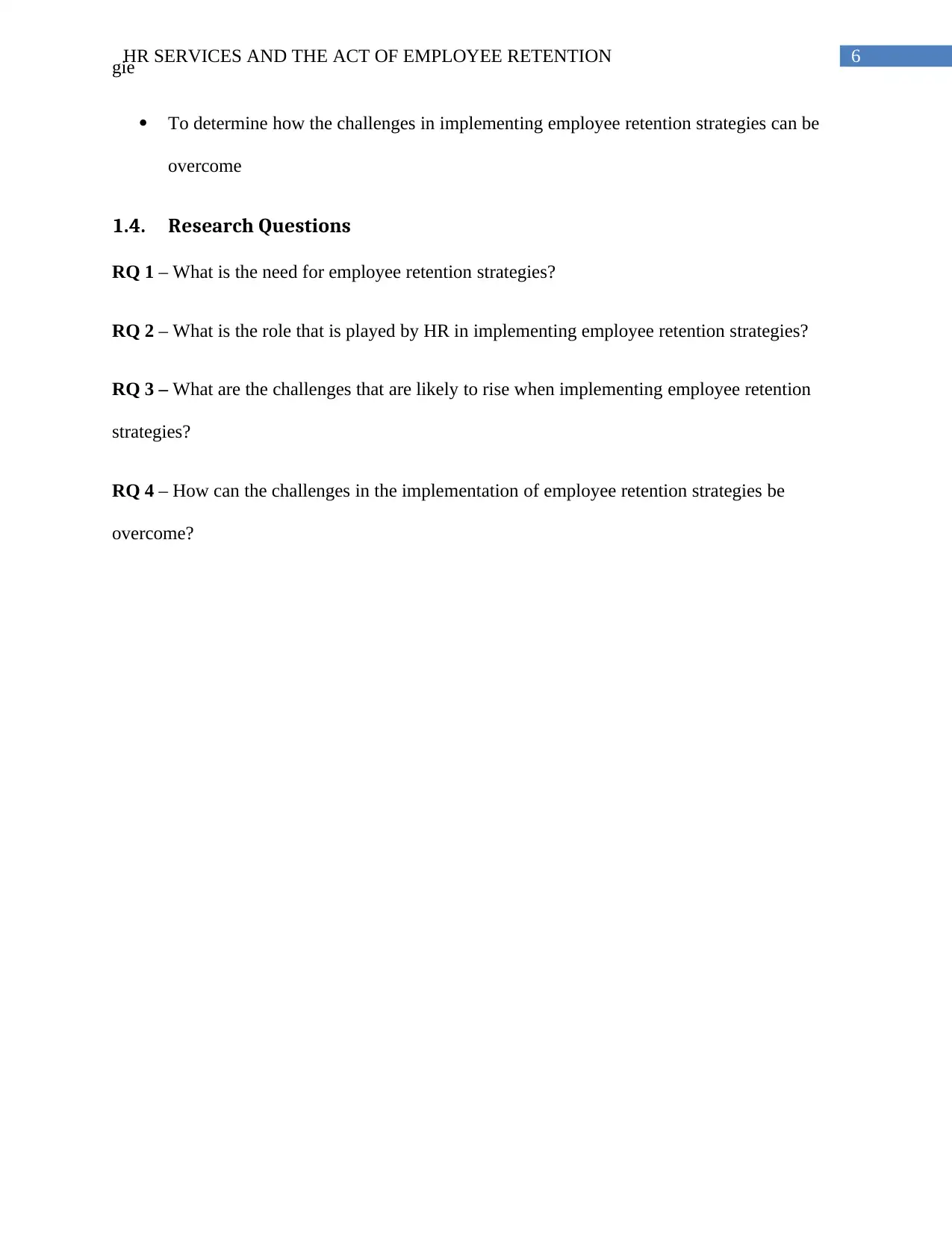
6HR SERVICES AND THE ACT OF EMPLOYEE RETENTION
gie
To determine how the challenges in implementing employee retention strategies can be
overcome
1.4. Research Questions
RQ 1 – What is the need for employee retention strategies?
RQ 2 – What is the role that is played by HR in implementing employee retention strategies?
RQ 3 – What are the challenges that are likely to rise when implementing employee retention
strategies?
RQ 4 – How can the challenges in the implementation of employee retention strategies be
overcome?
gie
To determine how the challenges in implementing employee retention strategies can be
overcome
1.4. Research Questions
RQ 1 – What is the need for employee retention strategies?
RQ 2 – What is the role that is played by HR in implementing employee retention strategies?
RQ 3 – What are the challenges that are likely to rise when implementing employee retention
strategies?
RQ 4 – How can the challenges in the implementation of employee retention strategies be
overcome?
Paraphrase This Document
Need a fresh take? Get an instant paraphrase of this document with our AI Paraphraser
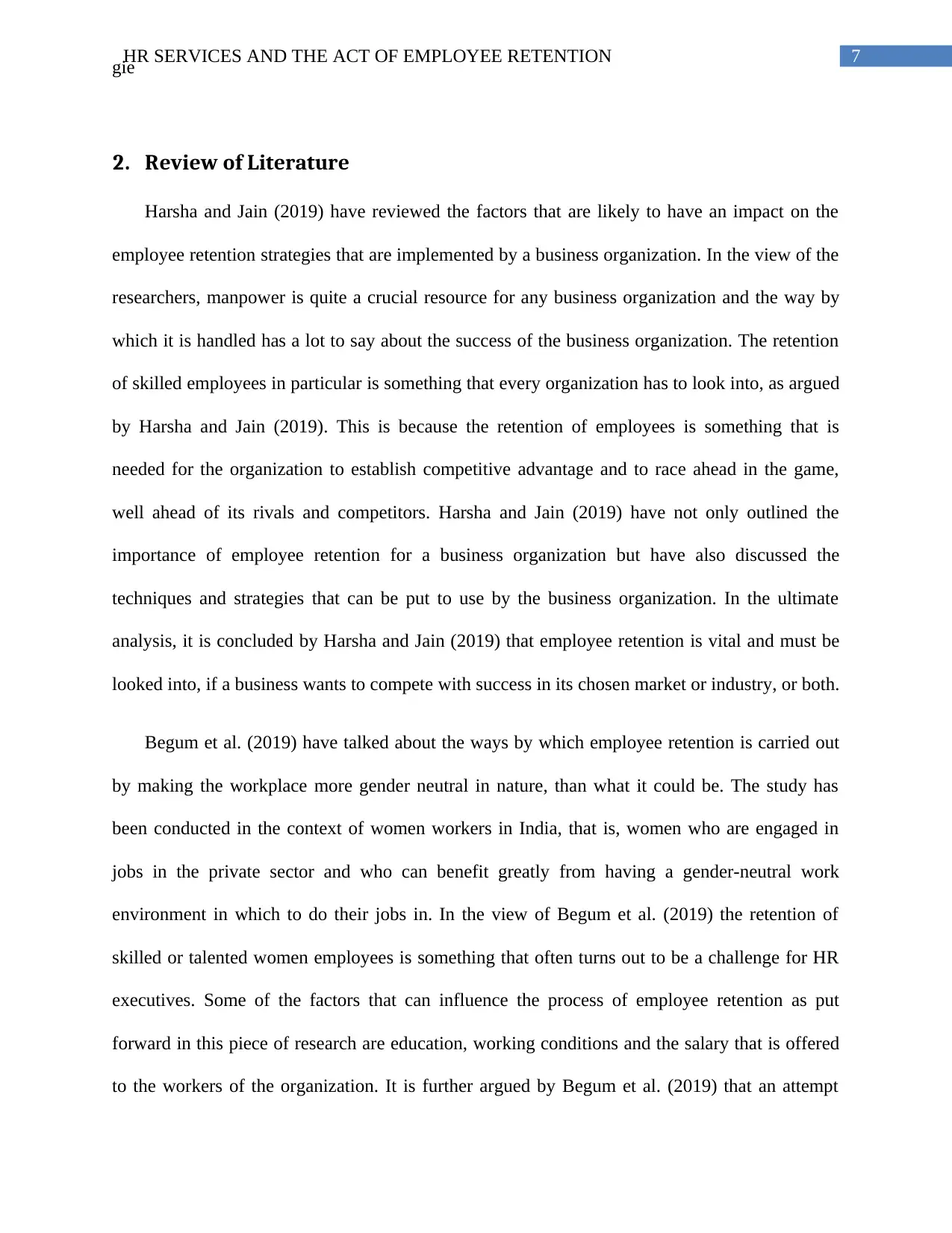
7HR SERVICES AND THE ACT OF EMPLOYEE RETENTION
gie
2. Review of Literature
Harsha and Jain (2019) have reviewed the factors that are likely to have an impact on the
employee retention strategies that are implemented by a business organization. In the view of the
researchers, manpower is quite a crucial resource for any business organization and the way by
which it is handled has a lot to say about the success of the business organization. The retention
of skilled employees in particular is something that every organization has to look into, as argued
by Harsha and Jain (2019). This is because the retention of employees is something that is
needed for the organization to establish competitive advantage and to race ahead in the game,
well ahead of its rivals and competitors. Harsha and Jain (2019) have not only outlined the
importance of employee retention for a business organization but have also discussed the
techniques and strategies that can be put to use by the business organization. In the ultimate
analysis, it is concluded by Harsha and Jain (2019) that employee retention is vital and must be
looked into, if a business wants to compete with success in its chosen market or industry, or both.
Begum et al. (2019) have talked about the ways by which employee retention is carried out
by making the workplace more gender neutral in nature, than what it could be. The study has
been conducted in the context of women workers in India, that is, women who are engaged in
jobs in the private sector and who can benefit greatly from having a gender-neutral work
environment in which to do their jobs in. In the view of Begum et al. (2019) the retention of
skilled or talented women employees is something that often turns out to be a challenge for HR
executives. Some of the factors that can influence the process of employee retention as put
forward in this piece of research are education, working conditions and the salary that is offered
to the workers of the organization. It is further argued by Begum et al. (2019) that an attempt
gie
2. Review of Literature
Harsha and Jain (2019) have reviewed the factors that are likely to have an impact on the
employee retention strategies that are implemented by a business organization. In the view of the
researchers, manpower is quite a crucial resource for any business organization and the way by
which it is handled has a lot to say about the success of the business organization. The retention
of skilled employees in particular is something that every organization has to look into, as argued
by Harsha and Jain (2019). This is because the retention of employees is something that is
needed for the organization to establish competitive advantage and to race ahead in the game,
well ahead of its rivals and competitors. Harsha and Jain (2019) have not only outlined the
importance of employee retention for a business organization but have also discussed the
techniques and strategies that can be put to use by the business organization. In the ultimate
analysis, it is concluded by Harsha and Jain (2019) that employee retention is vital and must be
looked into, if a business wants to compete with success in its chosen market or industry, or both.
Begum et al. (2019) have talked about the ways by which employee retention is carried out
by making the workplace more gender neutral in nature, than what it could be. The study has
been conducted in the context of women workers in India, that is, women who are engaged in
jobs in the private sector and who can benefit greatly from having a gender-neutral work
environment in which to do their jobs in. In the view of Begum et al. (2019) the retention of
skilled or talented women employees is something that often turns out to be a challenge for HR
executives. Some of the factors that can influence the process of employee retention as put
forward in this piece of research are education, working conditions and the salary that is offered
to the workers of the organization. It is further argued by Begum et al. (2019) that an attempt
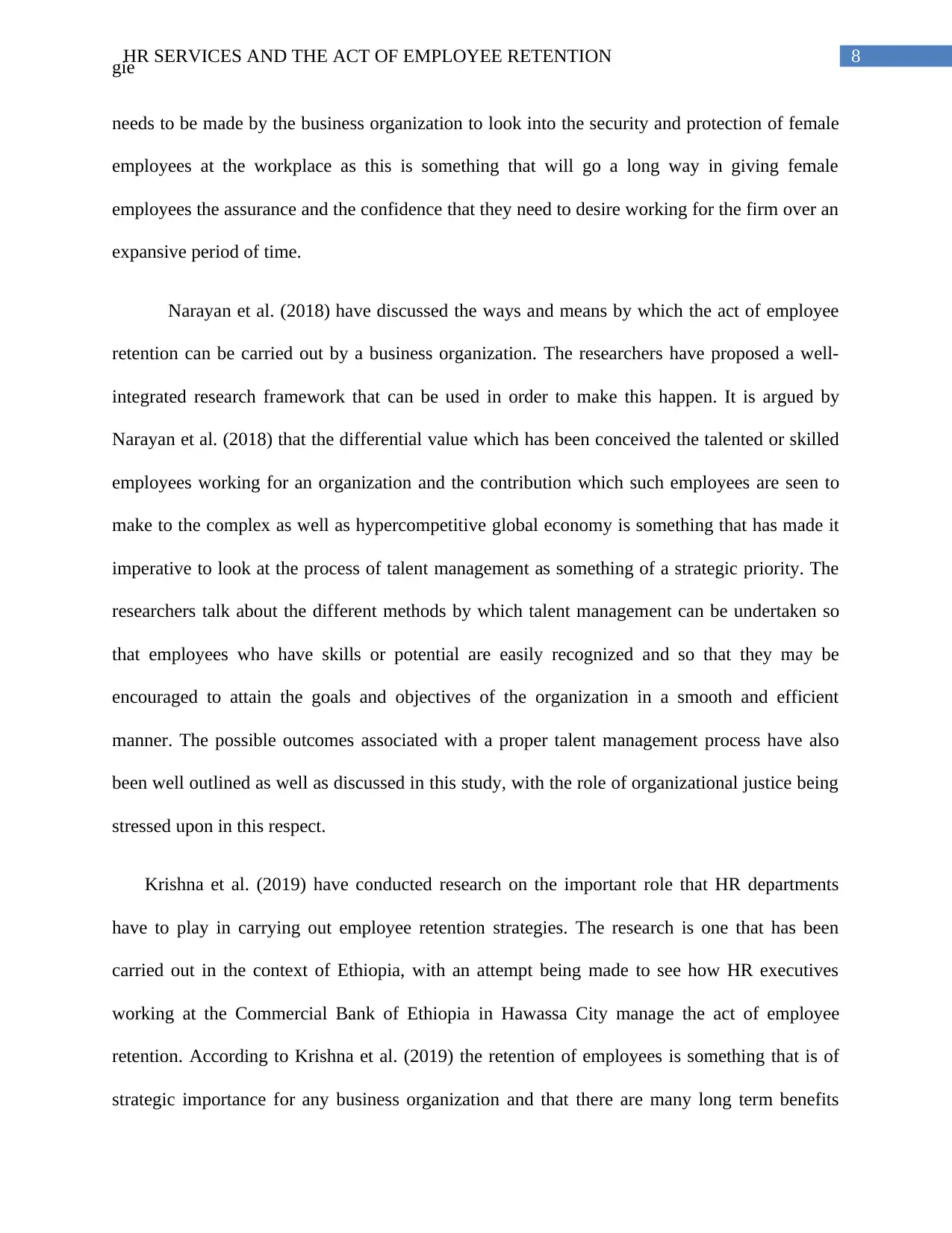
8HR SERVICES AND THE ACT OF EMPLOYEE RETENTION
gie
needs to be made by the business organization to look into the security and protection of female
employees at the workplace as this is something that will go a long way in giving female
employees the assurance and the confidence that they need to desire working for the firm over an
expansive period of time.
Narayan et al. (2018) have discussed the ways and means by which the act of employee
retention can be carried out by a business organization. The researchers have proposed a well-
integrated research framework that can be used in order to make this happen. It is argued by
Narayan et al. (2018) that the differential value which has been conceived the talented or skilled
employees working for an organization and the contribution which such employees are seen to
make to the complex as well as hypercompetitive global economy is something that has made it
imperative to look at the process of talent management as something of a strategic priority. The
researchers talk about the different methods by which talent management can be undertaken so
that employees who have skills or potential are easily recognized and so that they may be
encouraged to attain the goals and objectives of the organization in a smooth and efficient
manner. The possible outcomes associated with a proper talent management process have also
been well outlined as well as discussed in this study, with the role of organizational justice being
stressed upon in this respect.
Krishna et al. (2019) have conducted research on the important role that HR departments
have to play in carrying out employee retention strategies. The research is one that has been
carried out in the context of Ethiopia, with an attempt being made to see how HR executives
working at the Commercial Bank of Ethiopia in Hawassa City manage the act of employee
retention. According to Krishna et al. (2019) the retention of employees is something that is of
strategic importance for any business organization and that there are many long term benefits
gie
needs to be made by the business organization to look into the security and protection of female
employees at the workplace as this is something that will go a long way in giving female
employees the assurance and the confidence that they need to desire working for the firm over an
expansive period of time.
Narayan et al. (2018) have discussed the ways and means by which the act of employee
retention can be carried out by a business organization. The researchers have proposed a well-
integrated research framework that can be used in order to make this happen. It is argued by
Narayan et al. (2018) that the differential value which has been conceived the talented or skilled
employees working for an organization and the contribution which such employees are seen to
make to the complex as well as hypercompetitive global economy is something that has made it
imperative to look at the process of talent management as something of a strategic priority. The
researchers talk about the different methods by which talent management can be undertaken so
that employees who have skills or potential are easily recognized and so that they may be
encouraged to attain the goals and objectives of the organization in a smooth and efficient
manner. The possible outcomes associated with a proper talent management process have also
been well outlined as well as discussed in this study, with the role of organizational justice being
stressed upon in this respect.
Krishna et al. (2019) have conducted research on the important role that HR departments
have to play in carrying out employee retention strategies. The research is one that has been
carried out in the context of Ethiopia, with an attempt being made to see how HR executives
working at the Commercial Bank of Ethiopia in Hawassa City manage the act of employee
retention. According to Krishna et al. (2019) the retention of employees is something that is of
strategic importance for any business organization and that there are many long term benefits
⊘ This is a preview!⊘
Do you want full access?
Subscribe today to unlock all pages.

Trusted by 1+ million students worldwide
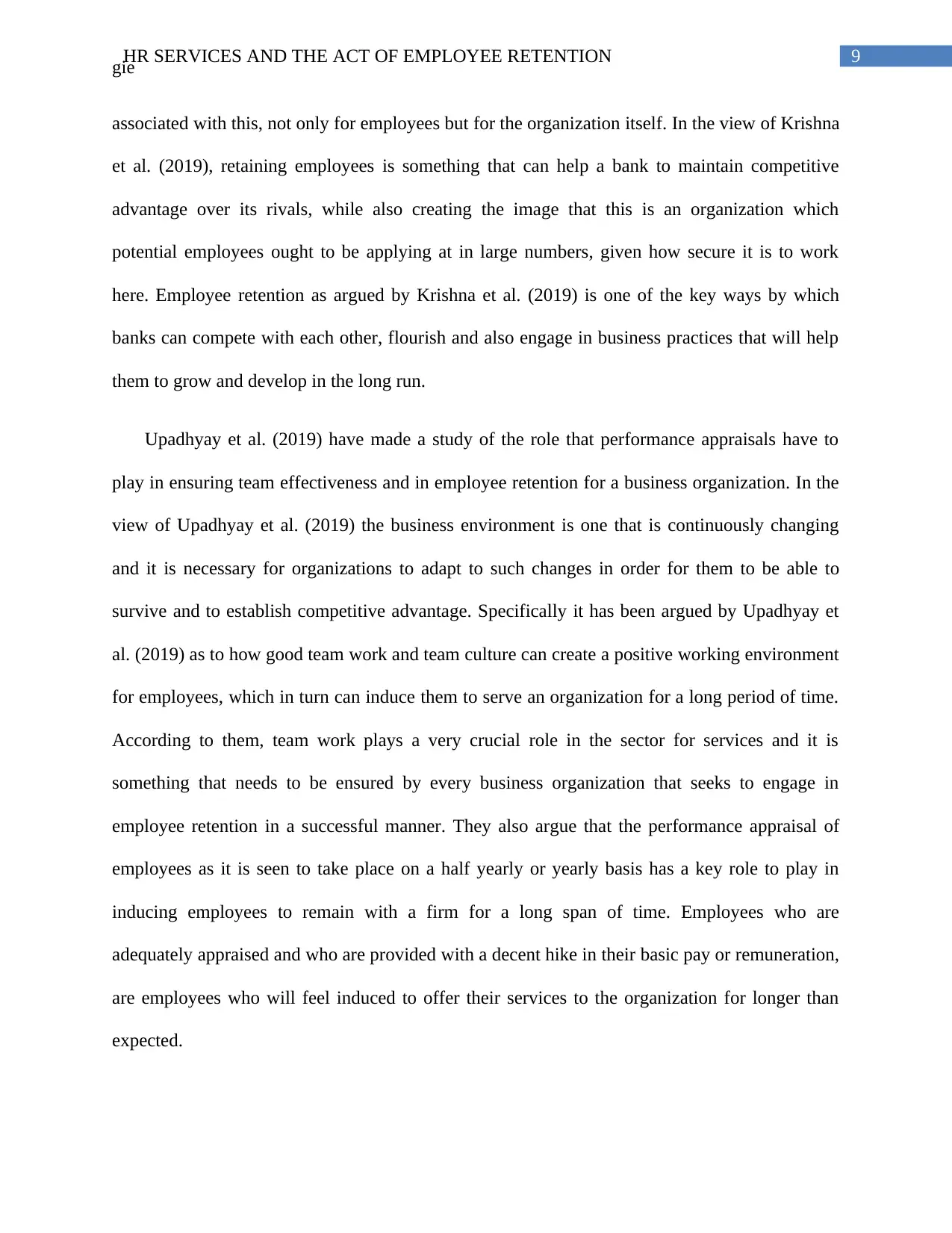
9HR SERVICES AND THE ACT OF EMPLOYEE RETENTION
gie
associated with this, not only for employees but for the organization itself. In the view of Krishna
et al. (2019), retaining employees is something that can help a bank to maintain competitive
advantage over its rivals, while also creating the image that this is an organization which
potential employees ought to be applying at in large numbers, given how secure it is to work
here. Employee retention as argued by Krishna et al. (2019) is one of the key ways by which
banks can compete with each other, flourish and also engage in business practices that will help
them to grow and develop in the long run.
Upadhyay et al. (2019) have made a study of the role that performance appraisals have to
play in ensuring team effectiveness and in employee retention for a business organization. In the
view of Upadhyay et al. (2019) the business environment is one that is continuously changing
and it is necessary for organizations to adapt to such changes in order for them to be able to
survive and to establish competitive advantage. Specifically it has been argued by Upadhyay et
al. (2019) as to how good team work and team culture can create a positive working environment
for employees, which in turn can induce them to serve an organization for a long period of time.
According to them, team work plays a very crucial role in the sector for services and it is
something that needs to be ensured by every business organization that seeks to engage in
employee retention in a successful manner. They also argue that the performance appraisal of
employees as it is seen to take place on a half yearly or yearly basis has a key role to play in
inducing employees to remain with a firm for a long span of time. Employees who are
adequately appraised and who are provided with a decent hike in their basic pay or remuneration,
are employees who will feel induced to offer their services to the organization for longer than
expected.
gie
associated with this, not only for employees but for the organization itself. In the view of Krishna
et al. (2019), retaining employees is something that can help a bank to maintain competitive
advantage over its rivals, while also creating the image that this is an organization which
potential employees ought to be applying at in large numbers, given how secure it is to work
here. Employee retention as argued by Krishna et al. (2019) is one of the key ways by which
banks can compete with each other, flourish and also engage in business practices that will help
them to grow and develop in the long run.
Upadhyay et al. (2019) have made a study of the role that performance appraisals have to
play in ensuring team effectiveness and in employee retention for a business organization. In the
view of Upadhyay et al. (2019) the business environment is one that is continuously changing
and it is necessary for organizations to adapt to such changes in order for them to be able to
survive and to establish competitive advantage. Specifically it has been argued by Upadhyay et
al. (2019) as to how good team work and team culture can create a positive working environment
for employees, which in turn can induce them to serve an organization for a long period of time.
According to them, team work plays a very crucial role in the sector for services and it is
something that needs to be ensured by every business organization that seeks to engage in
employee retention in a successful manner. They also argue that the performance appraisal of
employees as it is seen to take place on a half yearly or yearly basis has a key role to play in
inducing employees to remain with a firm for a long span of time. Employees who are
adequately appraised and who are provided with a decent hike in their basic pay or remuneration,
are employees who will feel induced to offer their services to the organization for longer than
expected.
Paraphrase This Document
Need a fresh take? Get an instant paraphrase of this document with our AI Paraphraser
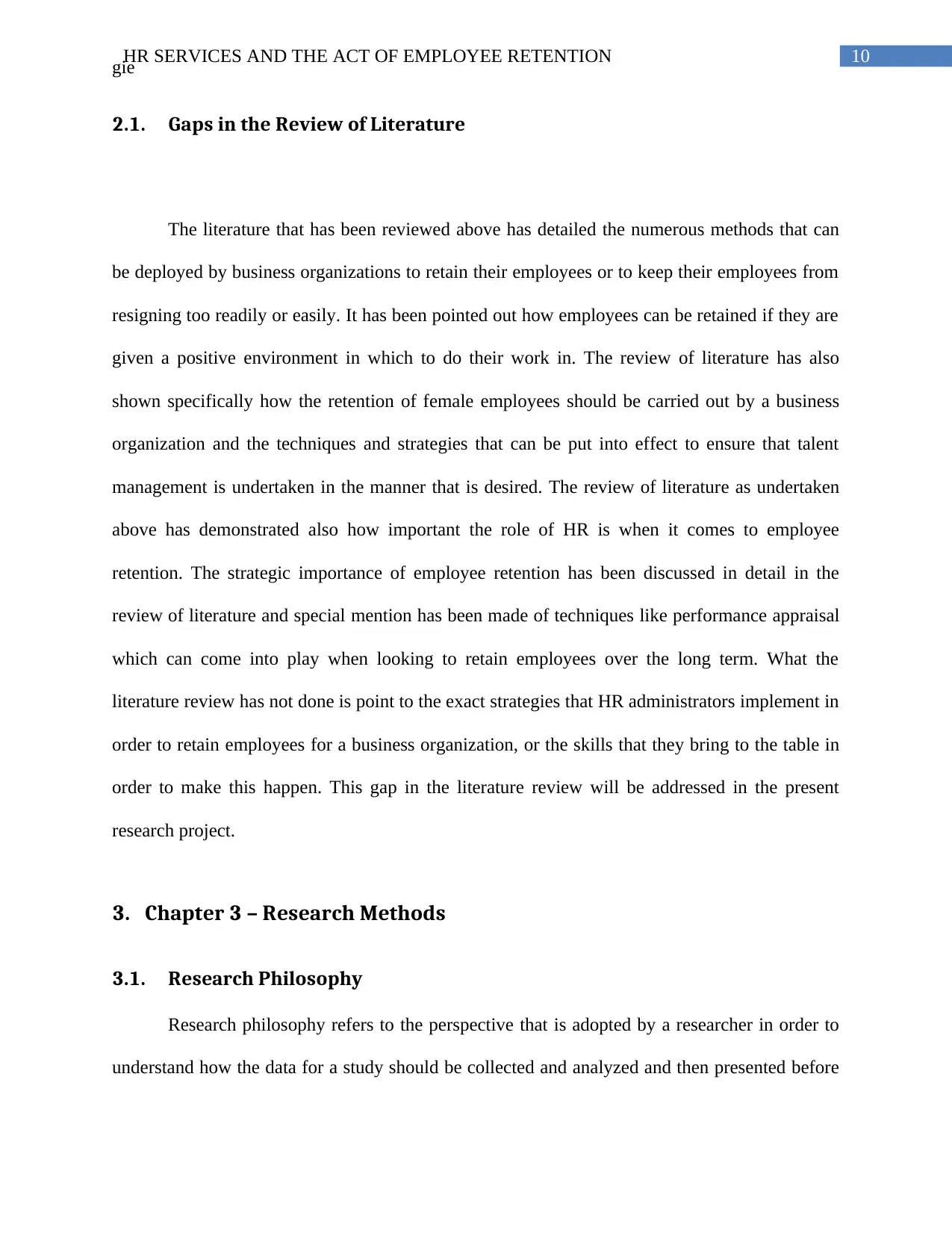
10HR SERVICES AND THE ACT OF EMPLOYEE RETENTION
gie
2.1. Gaps in the Review of Literature
The literature that has been reviewed above has detailed the numerous methods that can
be deployed by business organizations to retain their employees or to keep their employees from
resigning too readily or easily. It has been pointed out how employees can be retained if they are
given a positive environment in which to do their work in. The review of literature has also
shown specifically how the retention of female employees should be carried out by a business
organization and the techniques and strategies that can be put into effect to ensure that talent
management is undertaken in the manner that is desired. The review of literature as undertaken
above has demonstrated also how important the role of HR is when it comes to employee
retention. The strategic importance of employee retention has been discussed in detail in the
review of literature and special mention has been made of techniques like performance appraisal
which can come into play when looking to retain employees over the long term. What the
literature review has not done is point to the exact strategies that HR administrators implement in
order to retain employees for a business organization, or the skills that they bring to the table in
order to make this happen. This gap in the literature review will be addressed in the present
research project.
3. Chapter 3 – Research Methods
3.1. Research Philosophy
Research philosophy refers to the perspective that is adopted by a researcher in order to
understand how the data for a study should be collected and analyzed and then presented before
gie
2.1. Gaps in the Review of Literature
The literature that has been reviewed above has detailed the numerous methods that can
be deployed by business organizations to retain their employees or to keep their employees from
resigning too readily or easily. It has been pointed out how employees can be retained if they are
given a positive environment in which to do their work in. The review of literature has also
shown specifically how the retention of female employees should be carried out by a business
organization and the techniques and strategies that can be put into effect to ensure that talent
management is undertaken in the manner that is desired. The review of literature as undertaken
above has demonstrated also how important the role of HR is when it comes to employee
retention. The strategic importance of employee retention has been discussed in detail in the
review of literature and special mention has been made of techniques like performance appraisal
which can come into play when looking to retain employees over the long term. What the
literature review has not done is point to the exact strategies that HR administrators implement in
order to retain employees for a business organization, or the skills that they bring to the table in
order to make this happen. This gap in the literature review will be addressed in the present
research project.
3. Chapter 3 – Research Methods
3.1. Research Philosophy
Research philosophy refers to the perspective that is adopted by a researcher in order to
understand how the data for a study should be collected and analyzed and then presented before
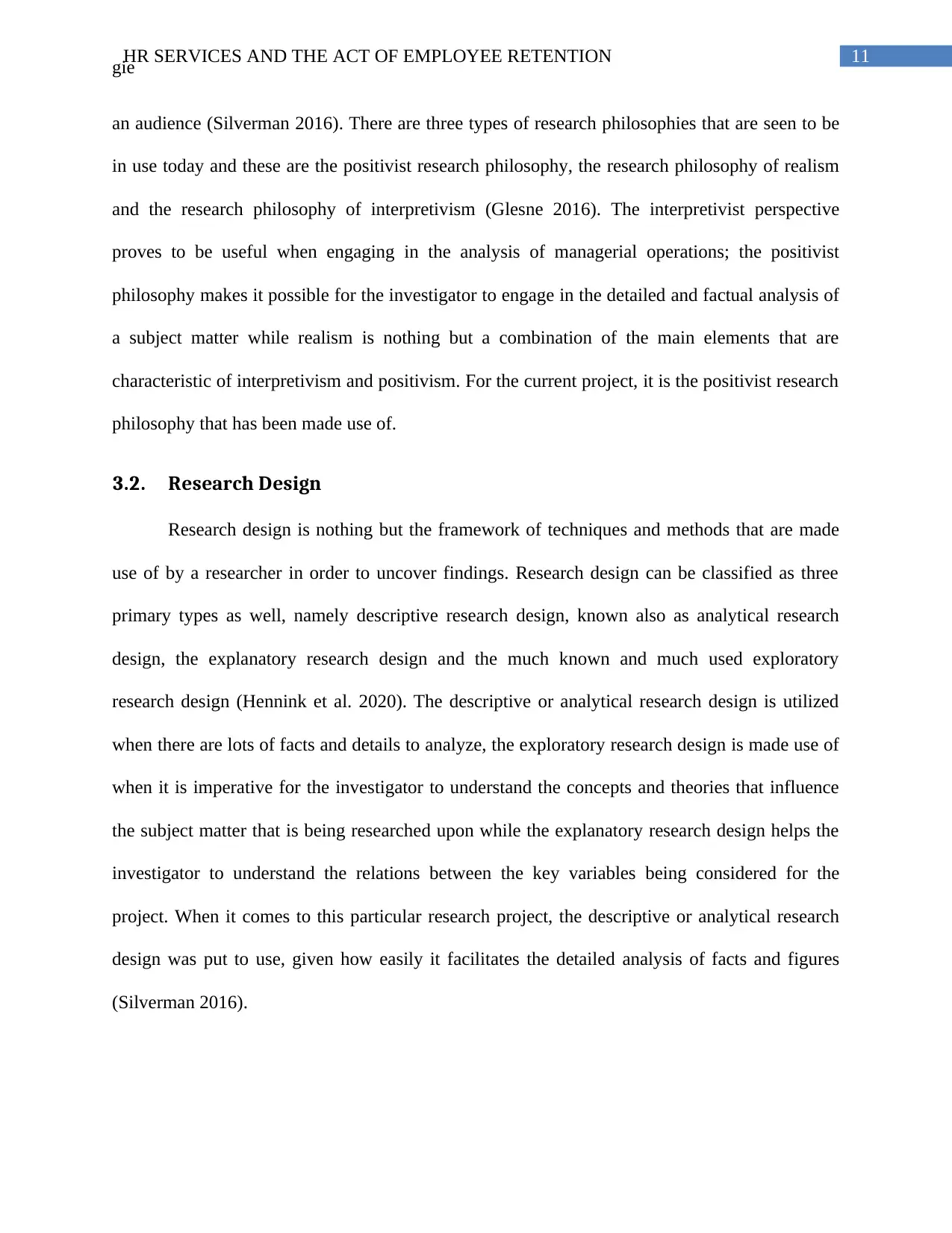
11HR SERVICES AND THE ACT OF EMPLOYEE RETENTION
gie
an audience (Silverman 2016). There are three types of research philosophies that are seen to be
in use today and these are the positivist research philosophy, the research philosophy of realism
and the research philosophy of interpretivism (Glesne 2016). The interpretivist perspective
proves to be useful when engaging in the analysis of managerial operations; the positivist
philosophy makes it possible for the investigator to engage in the detailed and factual analysis of
a subject matter while realism is nothing but a combination of the main elements that are
characteristic of interpretivism and positivism. For the current project, it is the positivist research
philosophy that has been made use of.
3.2. Research Design
Research design is nothing but the framework of techniques and methods that are made
use of by a researcher in order to uncover findings. Research design can be classified as three
primary types as well, namely descriptive research design, known also as analytical research
design, the explanatory research design and the much known and much used exploratory
research design (Hennink et al. 2020). The descriptive or analytical research design is utilized
when there are lots of facts and details to analyze, the exploratory research design is made use of
when it is imperative for the investigator to understand the concepts and theories that influence
the subject matter that is being researched upon while the explanatory research design helps the
investigator to understand the relations between the key variables being considered for the
project. When it comes to this particular research project, the descriptive or analytical research
design was put to use, given how easily it facilitates the detailed analysis of facts and figures
(Silverman 2016).
gie
an audience (Silverman 2016). There are three types of research philosophies that are seen to be
in use today and these are the positivist research philosophy, the research philosophy of realism
and the research philosophy of interpretivism (Glesne 2016). The interpretivist perspective
proves to be useful when engaging in the analysis of managerial operations; the positivist
philosophy makes it possible for the investigator to engage in the detailed and factual analysis of
a subject matter while realism is nothing but a combination of the main elements that are
characteristic of interpretivism and positivism. For the current project, it is the positivist research
philosophy that has been made use of.
3.2. Research Design
Research design is nothing but the framework of techniques and methods that are made
use of by a researcher in order to uncover findings. Research design can be classified as three
primary types as well, namely descriptive research design, known also as analytical research
design, the explanatory research design and the much known and much used exploratory
research design (Hennink et al. 2020). The descriptive or analytical research design is utilized
when there are lots of facts and details to analyze, the exploratory research design is made use of
when it is imperative for the investigator to understand the concepts and theories that influence
the subject matter that is being researched upon while the explanatory research design helps the
investigator to understand the relations between the key variables being considered for the
project. When it comes to this particular research project, the descriptive or analytical research
design was put to use, given how easily it facilitates the detailed analysis of facts and figures
(Silverman 2016).
⊘ This is a preview!⊘
Do you want full access?
Subscribe today to unlock all pages.

Trusted by 1+ million students worldwide
1 out of 29
Related Documents
Your All-in-One AI-Powered Toolkit for Academic Success.
+13062052269
info@desklib.com
Available 24*7 on WhatsApp / Email
![[object Object]](/_next/static/media/star-bottom.7253800d.svg)
Unlock your academic potential
Copyright © 2020–2025 A2Z Services. All Rights Reserved. Developed and managed by ZUCOL.





